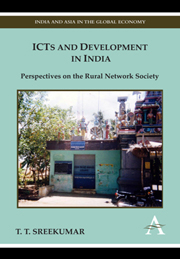Book contents
- Frontmatter
- Contents
- List of Figures and Tables
- Preface
- 1 Introduction: Exploring the Rural Network Society
- 2 Civil Society and Cyber–Libertarian Developmentalism
- 3 Decrypting E-Governance
- 4 Cyber-Kiosks and Dilemmas of Social Inclusion
- 5 Innovating for the Rural Network Society
- 6 ICT and Development: Critical Issues
- Notes
- Bibliography
- Index
6 - ICT and Development: Critical Issues
Published online by Cambridge University Press: 05 March 2012
- Frontmatter
- Contents
- List of Figures and Tables
- Preface
- 1 Introduction: Exploring the Rural Network Society
- 2 Civil Society and Cyber–Libertarian Developmentalism
- 3 Decrypting E-Governance
- 4 Cyber-Kiosks and Dilemmas of Social Inclusion
- 5 Innovating for the Rural Network Society
- 6 ICT and Development: Critical Issues
- Notes
- Bibliography
- Index
Summary
Civil Society, Community and ICTs
One of the consequences of the idea that ICT/community-based projects are necessarily virtuous was that most of the early approaches in ICT4D and Community Informatics did not critically examine how the historically formed social structures and social divisions within communities would impact the nature of ICT adoption and access. Ferdinand Tönnies, in his seminal study, made a distinction between communities (Gemeinschaft) and civil society (Gesellschaft) as two basic types of social groups (Tönnies [1887] 2002). He defined a community as an absolute unity that excludes the distinction between the parts; it is an indistinct and compact mass, an aggregate of consciousness bound in such a way that the parts cannot be separated. This is important because it does not allow any fragmentation within the community. This would then also mean that concepts such as class are not relevant for the community. Tönnies' definition tends to ignore class differences. The concept of community will thus be hiding social divides. It would then also mean that there would be no class consciousness – that consciousness be of the same nature, or very similar, is a necessity; the community is essentially the blood community, and family is identified as its nucleus. The advent of the Internet resulted in a renewed interest, both online and offline, in the study of community formation.
- Type
- Chapter
- Information
- ICTs and Development in IndiaPerspectives on the Rural Network Society, pp. 151 - 174Publisher: Anthem PressPrint publication year: 2011



